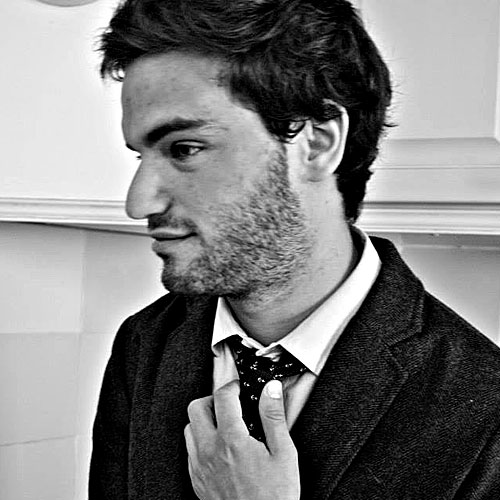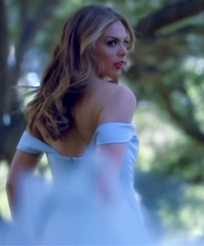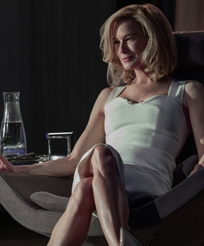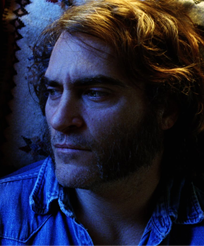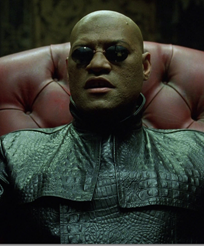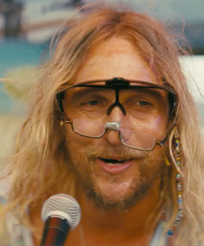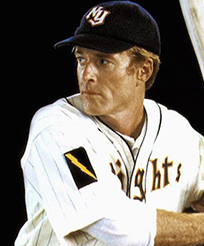Walking through Tribeca Film Festival’s Virtual Arcade can be a somewhat disorienting experience, even before you sample its panoply of virtual or augmented reality offerings. What’s that canopy-like contraption over there, vaguely resembling a shattered Transformer? (It’s part of a room-scale VR experience, using volumetric capture and a multiple storylines to plunge you into the mind of a grief-stricken lover). What’s inside that white room? (Put on the Oculus Rift and it becomes a bizarro-world Toronto for you to explore). Also, why are people strolling through what appears to be a yard sale, holding up viewers to their faces like masquerade ball masks? (That would be an augmented reality exhibit, wherein a hodgepodge of knick-knacks, junk antiques and ephemera trigger short videos, strangely juxtaposed with the tangible objects on which they appear.) To the uninitiated—i.e., someone like me, whose idea of “high-tech” is his iPhone 5s—the presence of such cartoonishly futuristic technology can feel, for lack of a better world, otherworldly.
By contrast, the booth for Dinner Party, a 13-minute narrative VR film produced by the innovative media company, RYOT, in conjunction with Telexist and Skybound Entertainment, and directed by Angel Manuel Soto, is weirdly familiar. Inside is an unremarkable dining room table, set for several guests with white plates, monogrammed cloth napkins, candles and glassware; on each plate awaits a black VR headset and a pair of over-ear headphones. Before sitting down, I hung my jacket on the kind of coat hook you might expect to find at cozy Midwestern home. With the jarring exception of the tech, the entire setup had the feel of a Norman Rockwell painting.
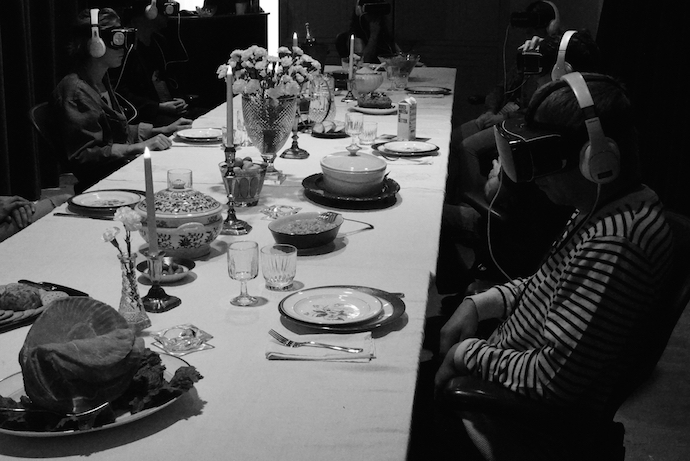
But when you put on the headset and headphones the physical realm disappears and you enter something like a black hole. I had the natural inclination to frantically whip my head around and get a sense of my surroundings; it felt, oddly, like what it feels like when you first realize you’re lost—suddenly, maddeningly lost—although obviously you’re not actually lost, you’re sitting in a place you sat down in a moment ago. Then you gaze downwards at the plate and the void opens up into a dining room, not unlike the one in the booth. As you glance around the room you may notice different pairs of guests—a few on a couch, others near the table—and catch scraps of ambient chitchat. It goes without saying that it feels like you’re there.
Dinner Party is based on the true story of Betty and Barney Hill, who made the first report of a UFO abduction in America, in 1961, though you might not realize that unless you read the synopsis—so immersive is this virtual world that it can take a few minutes for you to stop looking around and let the movie show you what it wants to show you. Eventually, though, the Hills place a tape player down on the table and press play: it’s the recording of the hypnosis they underwent to recover the memories of their extraterrestrial encounter.
The rest of the film unfolds from there, as Soto visualizes the Hills’ recollections. It gets pretty trippy. Driving down an empty road at night the Hills' car is subsumed by a blinding, spectral light. Betty becomes a kind of spirit, a constellational wisp floating pleasantly through the ether; devoid of her physical self, she seems to become one with the universe. Her recollection is of pure nirvana. Barney, meanwhile, experiences the abduction as a form of destruction—his body becomes a cluster of incandescent molecules, and he’s jerked uncomfortably through the void by an invisible force, crying out in agony. His recollection is of sheer terror. (That Barney is black, and Betty is white, and it’s 1961, and it’s America, gives this difference a political dimension.)

As incredible as the movie was—and words truly fail to do it justice—I’m not one of those people who believe it’s only a matter of time before VR movies replaces movie movies (although perhaps I’m being willfully naïve). During a movie, you feel directed; you see what the director wants you to see. During Dinner Party, you feel nudged; by the very nature of the medium, you the viewer acts as a quasi-cinematographer, with a certain level of agency on how to frame, or perceive, each shot. The degree of artistry and skill that must be required to make something like Dinner Party is unfathomable, at least to a layperson like me. Yet it seems to me a fundamentally different thing than traditional film.
The effect of Dinner Party is fundamentally different than a traditional film, too. While of course this was only my experience of it—though subjectivity seems uniquely appropriate when describing a movie you have to see alone, versus one you see in a crowded theater—I empathized with the Hills in a way I might not have characters in a normal movie. Not only because it felt like I was literally—or, well, virtually literally—right there with them. But also because my experience was such that I variably occupied Betty and Barney’s divergent sensations of being abducted: the exhilarating wonder, and the thrilling fear, of losing one’s self.

